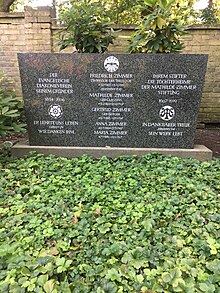Friedrich Zimmer
Karl Friedrich Zimmer (born September 22, 1855 in Gardelegen ; † December 5, 1919 in Gießen ) was a Protestant theologian and founder of the Evangelical Diakonieverein .
Life
Karl Friedrich Zimmer was born as the first of four sons of the seminar teacher of the same name and his wife Anna. Friedrich Zimmer spent the first four years of his life in his birthplace Gardelegen in the Altmark , then he moved with his family to Osterburg near Stendal . He attended the Schulpforta convent school and then studied theology in Tübingen .
After graduating as Dr. phil. and his habilitation in Berlin , he received a position as a private lecturer at the University of Bonn in 1880 , where he also met his future wife Mathilde Clausius, the daughter of the physicist Rudolf Clausius . When he took over a pastor's office in Mahnsfeld ( East Prussia ), he moved to the University of Königsberg , where he taught systematic theology . In the Königsberg Deaconess House of Mercy , Zimmer was appointed pastor , where, in addition to pastoral care of the sick, he also taught the deaconesses who worked there . In 1890 Zimmer was appointed director of the preacher's seminary in Herborn . After founding the Evangelical Diakonieverein , he remained in office as its board member until 1906. His other activities dealt with the organization of various social projects, including the colonial women's school in Witzenhausen and the Mathilde Zimmer Foundation . He was also a member of the Berlin Freemason Lodge Urania for Immortality . From 1905, Zimmer developed ideas for a nurses' academy. The military academy served as a model for him. He understood the two-year academic training at a nursing academy that he had anticipated as the second stage of the one-year nursing training at the time.
After his death in December 1919, he was buried in the Zehlendorf cemetery in Berlin, not far from the Heimathaus , the headquarters of the Evangelical Diakonie Association. Friedrich Zimmer rests next to his wife Mathilde geb. Clausius, who was buried in the same place in 1907. The couple's grave has been preserved.
plant
During the training of parish candidates in Herborn, Friedrich Zimmer also gained an impression of their future wives. The educational level of these women seemed to him insufficient for their upcoming tasks in the respective community, so that he began to consider how this deficiency could be remedied. At the same time, other developments were also underway that influenced Zimmer: On the one hand, the bourgeois women's movement was making efforts to enable women to live largely independently through education and training; On the other hand, changes in health care were necessary in the health system due to the progress in medicine. What previously untrained assistants carried out in the sense of “ nursing care ”, turned into special nursing for which trained staff was required. These individual aspects culminated in Zimmer's decision to found the Association for Ensuring Services in Diakonie (later named Evangelischer Diakonieverein ) on April 11, 1894. The first Diakonie seminar for nursing was set up on July 1, 1894 in the Elberfeld City Hospital . Here, women who had previously had school education were offered free training, which guaranteed them independence from family and marriage, and at the same time nurses could be placed in hospitals and communities. Further seminars emerged, including one for child nursing . Nursing schools have been established for women and girls from less educated classes . Furthermore, Friedrich Zimmer was the founder of daughter homes for girls who had previously had school education, who were to be prepared there for their work, marriage and family tasks. The first welfare and remedial education homes are also based on Zimmer's initiative.
literature
- Manfred Berger: ZIMMER, Karl Friedrich. In: Biographisch-Bibliographisches Kirchenlexikon (BBKL). Volume 25, Bautz, Nordhausen 2005, ISBN 3-88309-332-7 , Sp. 1583-1600.
- Liselotte Katscher: Nursing and the 'Third Reich'. The path of the sisterhood of the Evangelical Diakonie Association 1933-1939. Diakonie publishing house, Stuttgart 1990, ISBN 978-3923110636
- Ingrid Kracker von Schwartzenfeldt: Pictures of Life from the Evangelical Diakonieverein , Christian Zeitschriftenverlag, Berlin 1975
Web links
- History of the Evangelical Diaconal Association (accessed on May 21, 2016)
- History of the Mathilde Zimmer Foundation (accessed on May 21, 2016)
Individual evidence
- ↑ www.kulturfuehrer-berlin.de
- ↑ Karin Wittneben and Maria Mischo-Kelling: Pflegebildung und Pflegetheorien , Urban & Schwarzenberg, Munich, Vienna, Baltimore, 1st edition 1995, with a foreword by Hildegard Peplau , pp. 262–264.
- ^ Hans-Jürgen Mende : Lexicon of Berlin burial places . Pharus-Plan, Berlin 2018, ISBN 978-3-86514-206-1 , p. 680.
| personal data | |
|---|---|
| SURNAME | Zimmer, Friedrich |
| ALTERNATIVE NAMES | Zimmer, Karl Friedrich |
| BRIEF DESCRIPTION | German Protestant theologian and founder of the Evangelical Diakonie Association |
| DATE OF BIRTH | September 22, 1855 |
| PLACE OF BIRTH | Guards |
| DATE OF DEATH | December 5, 1919 |
| Place of death | to water |
